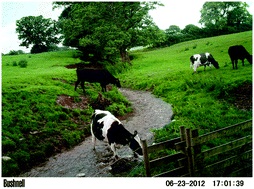The presence of cattle in close proximity to water courses can influence pollution levels in both direct and in-direct means. This study by researchers at Lancaster University reveals how these impacts can be best understood using simultaneous monitoring of both physical movement of cattle and water quality parameters.
Livestock farming in close proximity to streams can influence water quality in numerous ways. For example enhanced bank-side erosion and removal of vegetation can result in mobilization of sediments into water courses and increase turbidity. However, uncertainty exists regarding the extent to which the physical movement of cattle into and within the stream bed influences sediment resuspension and contribute to water quality degradation.
Previous studies assessing in-stream cattle impacts have focussed on short-term controlled events and often do not differentiate between bank-side and in-stream activity. The irregular behaviour of cattle means there is a need for high–frequency and simultaneous monitoring of cattle in-stream movement and water quality parameters over sufficiently long periods. This investigation by Julie Terry and co-workers at the Lancaster Environment Centre, UK attempts to assess the temporal relationship between physical in-stream activity of cattle and the level water quality.
This study investigated the physical movement of cattle in a stream and the impacts on suspended solid concentration (SSC) and observing a ‘signal response’ in an unfenced stretch of river in Cumbria, north-west England over a 4 month period. This involved the use of high resolution monitoring data derived using motion capture camera surveillance, taking over 31,000 images. At the same time, high resolution water quality data including turbidity (converted to SSC), water level and flow rate were also monitored.
It was shown that for the days when cattle were grazing nearby, of the instances that SSC exceeded 25 mg/l (the Freshwater Fish Directive guidance threshold), 58% could be attributed to the presence of cattle. However, only 3.6% of total sediment load in the stream was directly caused by cattle in-stream activity. Flow is still the main factor influencing total sediment transported, with cattle contributing a much smaller proportion. No relationship was noted between SSC response and absolute number of cattle feet in the water, attributed to the episodic nature of cattle-related sediment disturbances and the variability in stream flow.
Hysteresis analysis (modelling the relationship between concentration levels and discharge) demonstrated a lag time between the presence of cows in the stream and a critical amount of their contribution to SSC with a reoccurring ‘first-flush’ of sediment created from non-cattle activity. It was indicted, however that cattle can also provide considerable contribution indirectly e.g. due to erosion of stream banks.
Don’t let this work go in one ear and out the udder. It demonstrates the impact cattle can have on water quality in unprotected and unmonitored stretches of river and indicates the need for best practice measures for livestock management need to be adhered to closely in order to reduce maintain the ecological status of water courses. The authors have demonstrated the need for high-resolution monitoring data is to best understand and mitigate against these dangers and also outline directions for further work to compliment these results.
To access the full HOT Article for free*, click the link below:
Temporal dynamics between cattle in-stream presence and suspended solids in a headwater catchment
Julie A. Terry, Clare McW.H. Benskin, Emma F. Eastoe and Philip M. Haygarth
Environ. Sci.: Processes Impacts, 2014,
DOI: 10.1039/C3EM00686G
*Access is free for the next 4 weeks through a registered RSC account – click here to register











